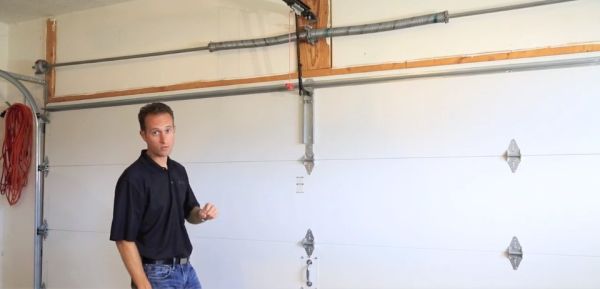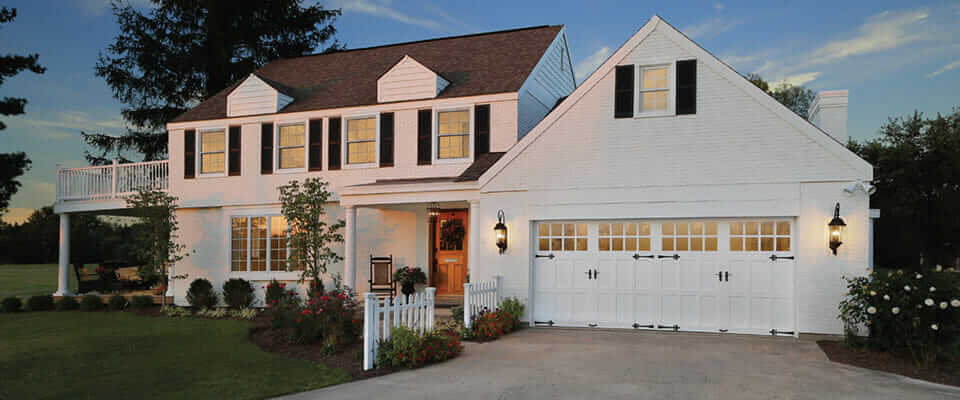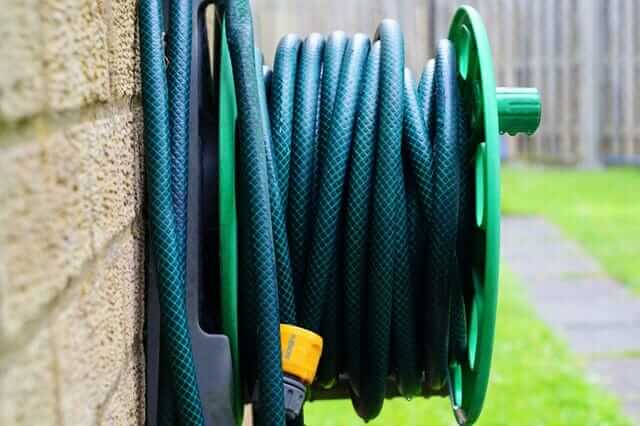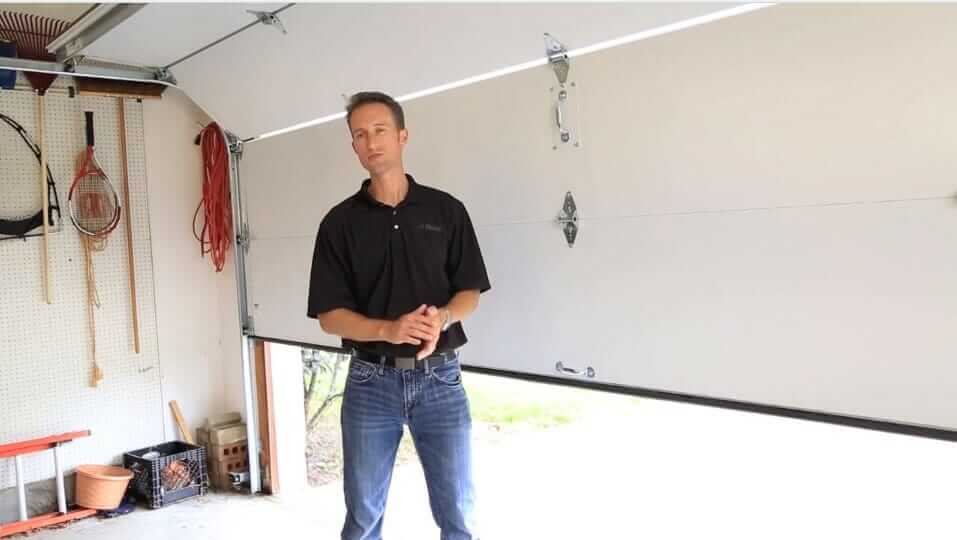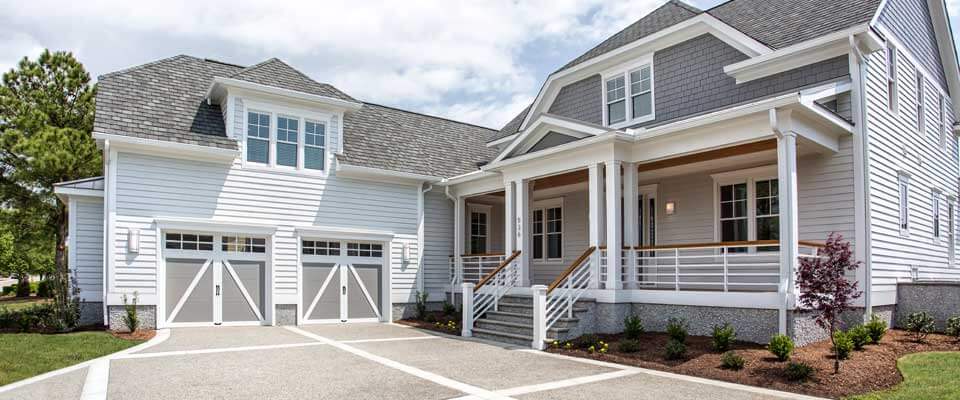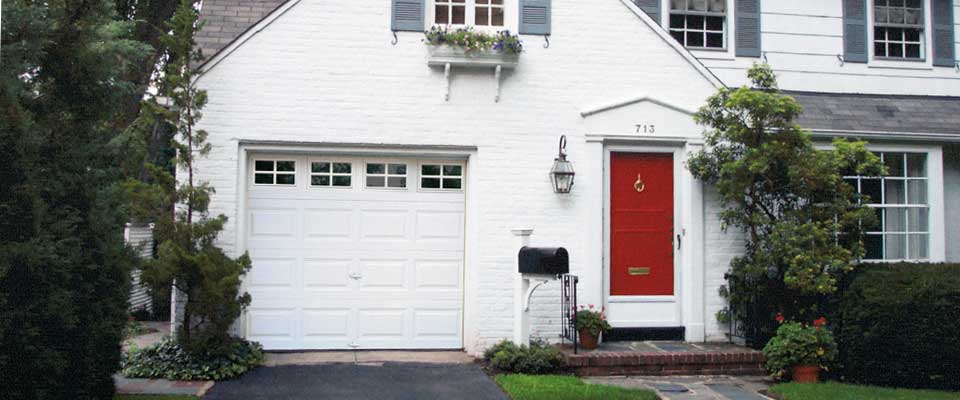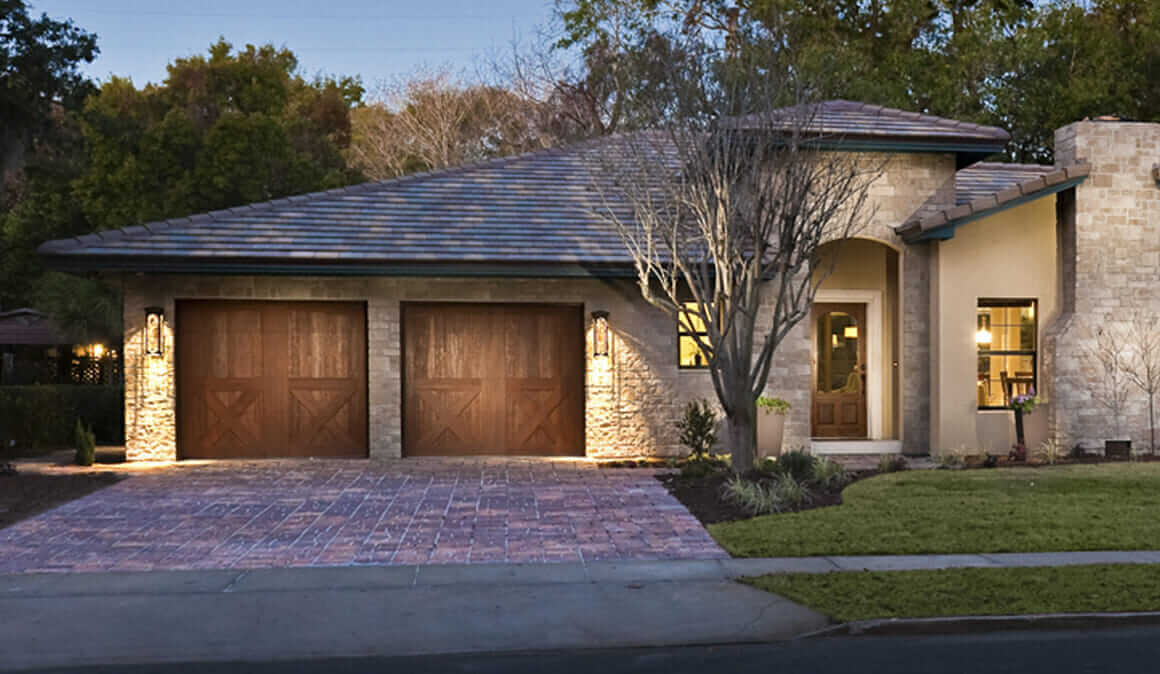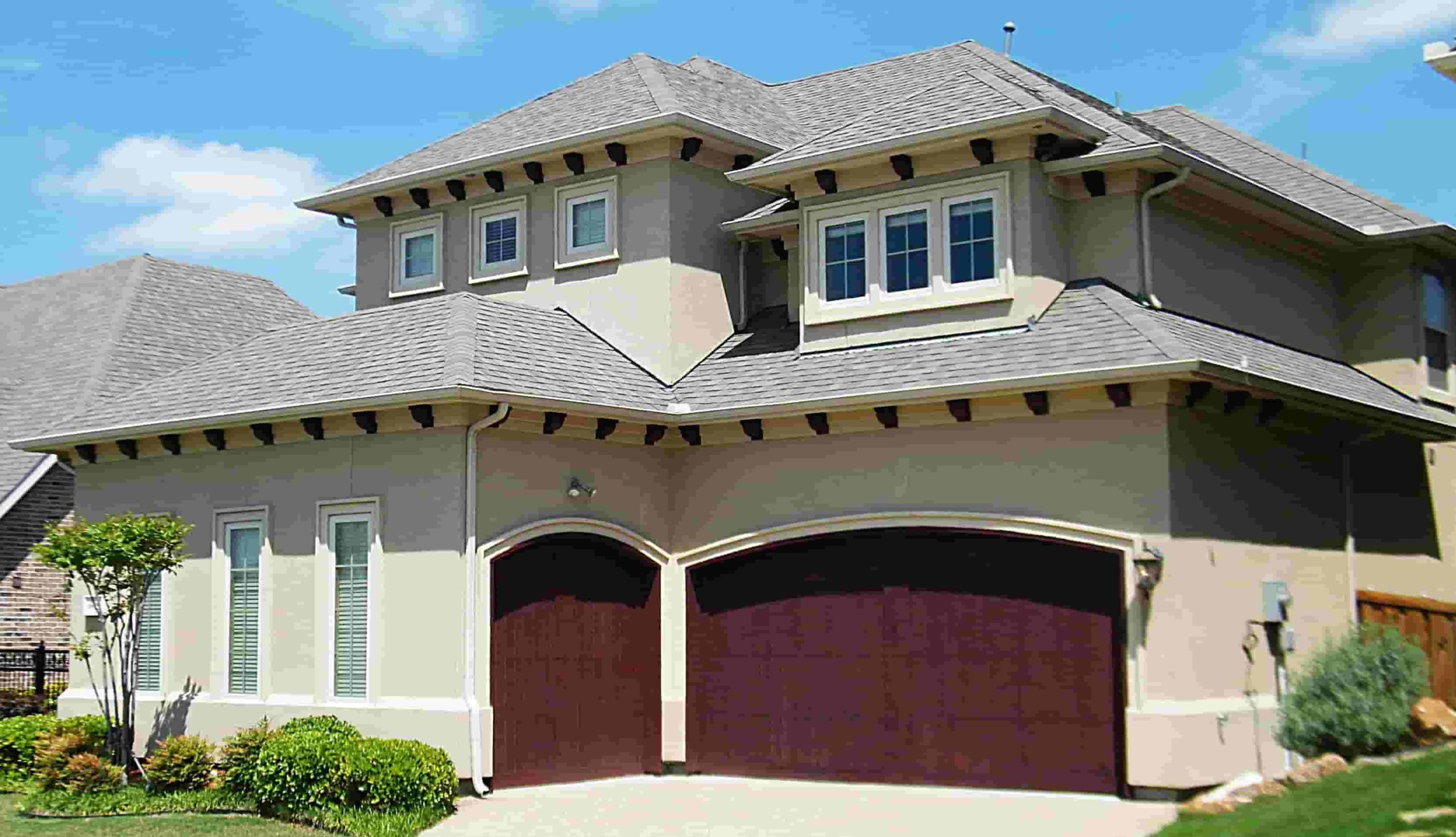How Often Should I Service My Garage Door and How?
Garage doors are one of the hardest-working parts of your home. You rely on them day in and day out to open and close on your command. It’s little wonder that these doors need some TLC to continue functioning well all the time.
To keep your garage door properly maintained, you should have it professionally serviced annually. In addition, be sure to conduct your own monthly checks of the door to ensure it is working correctly. Learn more about the most common items a service technician will inspect each year and how to perform your own monthly checkup.
Why Should I Service a Garage Door?
Servicing your garage door helps to extend its life. When you get annual service for your garage door, it’s a lot like going to a physical. There, a physician checks you for signs of potential problems and treats any issues they find. It’s the same for a garage door.
Service ensures a small problem doesn’t turn into a big one. For instance, at your service appointment, a technician may identify a spring that’s about to break and replace it. You won’t be caught off guard by a broken garage spring and have to wait around until someone can come to repair your door. Plus, it can save you money since it won’t require emergency service.
How Professionals Service a Garage Door
A garage door is the largest moving object in your home. It is extremely dangerous to perform some service and repairs, which is why it is best left to a professional technician. Professionals have a checklist of issues to look for when they inspect a garage door. They may start by oiling squeaky tracks and examining the overall health of the system. Then they will perform individual checks, such as:
- Springs: Examine torsion springs to ensure they have the right level of tension.
- Cable: Check the cable for signs of fraying and replace anything that looks worn.
- Roller: Look for signs of bending or breakage.
- Door sections and panels: Search for signs of disrepair, which can impact the garage door opener as well.
- Garage door opener: Use for opening and closing several times to ensure the door is balanced.
How to Maintain Garage Doors by Yourself
In addition to having your garage door professionally inspected annually, you can also look after your system yourself by following these simple maintenance tips:
- Check your garage door alignment: Unhook the opener, then raise and lower the door by hand. If it’s really tough to do, you may have door alignment issues.
- Test the function of the “eye:” The garage door eye tells your opener when it’s OK to open or close the door. Press the garage door opener button to close the door, and place a broom in front of one of the eyes. If the door stops, the eye is fine, but if it doesn’t, you should get assistance immediately as it’s a safety issue.
- Clean out debris: Keep the garage floors and door tracks clean and free of debris.
Trust Custom Door & Gate for Your Garage Door Needs
Do you need a professional to assist you with garage door maintenance? Custom Door & Gate offers annual maintenance plans for residents of Raleigh and surrounding North Carolina communities. Get in touch today to learn more about our services.
How to Minimize Bugs and Other Pests from Entering Your Garage
Garages service the purpose of protecting vehicles, neatly storing items, and can even double as additional workspace.
While the garage is a practical and adaptable household area, it’s also often home to a range of bugs and other pests. During a hot summer, insects are looking for a reprieve from the heat and a reliable water source, while in the winter, they need protection and warmth. Finding critters in your garage is often unsettling and inconvenient, but there are several quick methods to remove unwanted housemates and help minimize future infestations.
Common Garage Pests
As a homeowner, you are probably accustomed to finding pests and insects on your property. These sightings can range from a minor inconvenience like flies buzzing around to major problems that can lead to property damage, such as mice and birds nesting within the walls and ceiling. Most pests seek shelter in garages because they often represent a steady source of food, water, nesting opportunities, and light.
The most common types of bugs and pests you’ll find in garages include:
- Flies
- Silverfish
- Crickets
- Spiders
- Cockroaches
- Ants
- Moths
- Mice
- Birds
How to Keep Insects and Other Pests Out of Your Garage
If you’ve recently found bugs and other critters living in your garage, it’s important to remove them quickly and take the necessary steps to prevent them from returning. You can minimize bugs and pests from getting into your garage with these solutions:
- Remove existing critters: Incorporating preventive measures throughout your garage won’t do any good if there’s already pests nesting in the space. Inspect your garage and note any signs of an infestation, then call a pest control company to remove any bugs or pests.
- Clean out the garage: Once all insects and pests have been removed, clean out your garage by sweeping the floors, removing debris and replacing boxes with plastic storage containers. Keep containers and other items on shelving to eliminate hiding spots and nesting opportunities. Remove any food and place pet food in airtight containers. Then, look for moisture sources and dry any standing water with a portable fan.
- Inspect for cracks: Prevent pests from entering your garage by checking for cracks in the foundation, walls, and ceilings as well as gaps in exterior doorways and windows. Seal any gaps or cracks with silicone caulk.
- Lay traps: For sneaky pests that still find a way into your garage, set up traps around entrances and spray pesticides around doors, windows and along walls.
- Check the garage door: Take a look at your garage door and inspect its condition — gaps between the weatherstripping and the garage floor can invite pests.
Keep Pests and Insects Away With Garage Door Maintenance From Custom Door & Gate
If you’re battling an ongoing pest infestation, trust the experts at Custom Door & Gate to inspect your garage door system and develop a solution so your home can be pest-free. With routine garage door maintenance, our team will assess your door for signs of wear and inspect and replace your weatherstripping as needed. To schedule garage door maintenance services, call us today at 919-457-9489 or fill out our online contact form.
Ideas For Converting Your Garage
Like many homeowners, you’ve probably found yourself wishing you had more space in your home.
Unfortunately, home renovations and expansions can be very costly. The good news? You may be overlooking a space in your home that can be easily converted: your garage.
Garage Room Ideas
Need some inspiration to envision your garage as a living space? We’ve put together a few garage room ideas to get you started:
- Game room: Add a pool or air hockey table to take your next get-together up a notch. Or maybe video games are more your style — either way, your garage can be the perfect gaming space.
- Home office: If you’re one of the many Americans who work from home or have a side hustle, you know how important it is to have an office space.
- Reading nook: Wishing you had a special place to curl up with a good book and relax? Make it happen! Or if you unwind in a different way, adjust accordingly. You can easily add a bar cart and some comfy seating, for example.
- Craft room: Maybe your craft is woodworking, ceramics, scrapbooking or knitting. Whatever it is, a dedicated space can make it that much more enjoyable — and free up space elsewhere.
Of course, these are only a few ideas. You could also change your garage into a living room, a laundry room, a guest bedroom or even a home gym. This is an opportunity to get creative and turn your house into the home of your dreams!
Think about it — your garage is already an extension of your home. Converted properly, garages can easily function as living spaces. Of course, you should always consider the pros and cons before making any significant updates to your home. Here are a few things to keep in mind:
- Adding livable space can increase the value of your home.
- Converting a garage into a room is a budget-friendly house extension.
- Since the structure is already built, you can do most of the work yourself without hiring a professional.
Some of the downside factors to consider before converting your garage include the following:
- You’ll lose the dedicated space for your car.
- While it’s less costly than an expansion, converting your garage can still be pricey depending on its current state.
- ou may need a permit for a garage conversion. Double-check before beginning your project!
How to Convert a Garage Into a Living Space
Do you have your heart set on converting a garage into a room? Following are the first steps you’ll need to take to ensure a functional living space:
- Insulate the walls and ceiling if you haven’t already, but don’t stop there. A properly insulated garage door will have a profound effect on temperature control.
- Install drywall and flooring.
- Upgrade the electrical wiring. You’ll want plenty of lighting in your new space.
- Connect to your home’s HVAC unit or install an independent system to regulate temperature.
Your next steps might vary depending on the type of room you have in mind. You may want to paint, measure the room for new furniture and/or finish up any carpentry. The sky’s the limit — just have fun customizing your new room!
Finish Your Renovation With a New Garage Door
Top off your brand new garage room with an updated garage door! A new door will ensure that your room is properly insulated and protected from the elements. Plus, it will add curb appeal and style.
Contact Custom Door & Gate for installations and repairs. We have more than 25 years of experience making homes like yours beautiful.
How To Properly Clean Your Garage Door
Your garage door needs to be cleaned periodically, as it’s constantly exposed to the elements. A clean garage door can go a long way toward increasing the curb appeal of your home — after all, your garage door makes up a significant part of the visible exterior of your home.
If that’s not enough to convince you, keep in mind that many newer garage doors come with a warranty, and some warranties can be voided by failure to keep your garage door clean. A buildup of dirt or oil on the tracks can lead to mechanical breakdowns that may not be covered. You can save yourself money — and a few headaches — by making sure your garage door is in good shape.
But how often should you clean your garage door? What kind of tools should you use? We’ve put together this guide to help you get started on washing your garage door.
When to Clean Your Garage Door
In general, homeowners should clean their garage doors at least twice a year — in spring and again in autumn. But if you live in an area where your home is exposed to more extreme elements — such as a coastal region — you might notice that your garage door needs to be cleaned more often. If you notice a buildup of pollen, oil or any visible dust or dirt on your door, you should take the time to clean it as soon as you get a chance.
What Tools to Have on Hand
The tools you’ll need include:
- A bucket filled with water
- A hose
- A soft rag
- Gentle soap
Here’s an additional tip: Wear rubber gloves and clothes you don’t mind getting dirty!
The Best Way to Clean Garage Doors
Here’s a step-by-step guide to cleaning your garage door:
- Mix a gentle soap or cleaning solution with water.
- Wet the surface of the door with a garden hose.
- Working in sections, start scrubbing with a soft rag or bristle brush and your cleaning solution mixture.
- Use the hose to rinse the section you’ve just washed.
- Move to the next section and repeat until you’re finished!
If you find any stubborn oil stains, you can remove them with a mixture of bleach diluted with water. Be sure to wear gloves, and rinse the area thoroughly before using bleach — mixing bleach with household cleaners is dangerous.
How to Clean Garage Door Windows
If your garage door has windows, you can clean them the same way you clean any other window in your home. A gentle cleaner is always best. Make sure to be extra careful around any seals or weather stripping.
What Not to Do When Washing Garage Doors
Here are a few things you should avoid when cleaning your garage door to avoid damaging it:
- Don’t use a pressure washer.
- Never mix the cleaner with bleach.
- Avoid using abrasive sponges or scouring products that can damage the finish of your door.
Time for a Repair? Call Custom Door & Gate
Cleaning your garage door regularly is one of the things you can do to keep it in working order. Taking the time to clean also gives you a chance to do a quick inspection of any issues. For more significant repairs and services, don’t hesitate to contact Custom Door & Gate.
Benefits Of A Side Mount Garage Door Opener
Side mount garage door openers, also known as jackshafts, come with many advantages, such as space efficiency and low maintenance. But those two features are just the beginning. If you’re looking to take your garage experience to the next level, this is the door opener for you. It’s affordable, durable, reliable and easy to take care of.
This garage door opener can also be placed out of sight, so when you pull in to your garage, you’ll be greeted by clean lines and an unobstructed ceiling.
Benefits of Side Mount Garage Door Openers
In each home, two things remain important: space and maintenance. In a perfect world, you would be able to maximize the square footage in your home and keep all appliances and fixtures down to zero maintenance. The jackshaft garage door opener fits that description. Here is a list of some of the advantages of side mount garage door openers:
- Does Not Obstruct the Ceiling: Side mount garage door openers are mounted on the side wall of the garage door, hence their name. If you have a large vehicle parked in the garage, this is an excellent option. Mounting your opener on the side will also open up more overhead storage space in your garage.
- No Need for Rails: With a side mount, you don’t need rails to hang your opener from.
- Easy to Maintain: The main benefit of lubricating a jackshaft is that it will not drip on your floor or car. You also won’t need to adjust your door due to cable stretch. Since this opener does not require rails, there’s also one less part that needs cleaning.
- Saves Space: Unlike trolley bar installations, that take up space in the headroom of a garage, jackshaft openers are mounted on the side and create more space in your garage.
It is important to mention that in order to have a jackshaft installed, your garage can’t have low headroom. A high lift ceiling is necessary for this kind of opener. Your garage also needs to have an outlet at the head of the garage near the door. Lastly, you must have space on the sides of the door to install side mount garage door openers.
Why Work With Custom Door & Gate?
We have been repairing and installing commercial and residential garage doors for over 30 years — which means we have experience installing and repairing garage doors of all models, sizes, and types. When it comes time for you to purchase a jackshaft garage door opener, we’ll be here to help ensure a smooth installation. We also offer services in gate security, access control systems, and more.
If you’re looking for a partner to deliver quality and expertise for your garage door needs, trust Custom Door & Gate. Contact us today.
How To Properly Lubricate A Garage Door
If you ever notice an awful screeching noise coming from your garage door, it’s a sign your door needs a health check-up.
Since the screws, springs, hinges, and tracks are all made of metal, they need to stay lubricated. Knowing how to lubricate a garage door will help increase its longevity and give your ears a break.
How to Lubricate a Garage Door
The proper way to lubricate your garage door starts with using the right solution. We recommend using a non-silicone lubricant such as LPS 2.
Always avoid spraying WD-40 on any part of your garage door. People often mistake this product, which contains anti-rust and degreasing properties, with a lubricant because the bottle states it helps parts move more smoothly. But WD-40 is a cleaning solvent, not a lubricant. It’s also important to avoid using grease at all costs. Grease will create a stickiness that’s hard to clean, so it can lead to a faster buildup of damaging debris.
Parts of Garage Door to Lubricate
Many parts of a garage door require frequent lubrication for smooth opening and closing operation, which should be part of your self-designed garage door preventive maintenance. Before lubricating, be sure to clean all parts with a dry cloth to remove any dust or debris. As you begin the lubrication process, use another dry cloth to clean as you go, avoiding excessive dripping on the garage floor.
Once you’re all set, you can begin to lubricate the following parts:
- Hinges: Lubricate the hinges at their pivot points. Only do this for metal hinges, though. Avoid applying anything to plastic parts. Some lubricants can cause the plastic to break down over time.
- Rollers: Metal rollers are how your garage door travels up and down. If your rollers feature nylon wheels, be sure to lubricate the rollers without getting any lubricant on the nylon material. While metal rollers require less precision, it’s a good idea to protect your floor and your car from any drips along the way.
- Springs: Locate the torsion springs that lift and lower your garage door. This is one of the most important parts of a garage door to lubricate because lubricating the springs can increase their efficiency as well as their lifespan. Apply just enough to make them move better.
It’s crucial that you do not apply any solution to the bearings or tracks of your door. You can clean them to ensure they are functioning at their best, but lubricant will not help these parts perform better.
Get in Touch With Us at Custom Door & Gate for Your Garage Door Needs
If your garage door isn’t working as it should or you have any questions about how to lubricate your garage door, contact us today. We’re here to help.
Benefits of an Insulated Garage Door
With so many different types of garage doors, materials, styles and colors to choose from, you have a big decision when replacing your garage door. When shopping for a new garage door, it’s not just about the look. You have to consider the different features, too.
Insulation gives lots of great benefits to your garage door, but insulation does not come standard in every door out there. If you’re considering whether you need an insulated garage door, check out these three benefits you get from garage door insulation.
1. Temperature Control
With an insulated garage door, you can keep your garage at a steadier temperature. In the summer, the insulation will help keep the heat out. Similarly, during the winter months, the insulated garage door will help keep out the cold. The clear advantages are that your garage won’t feel swelteringly hot in the summer and freezing cold in the winter.
If you don’t have an insulated garage door, it can drive up your energy bills. The extreme temperatures in the garage can affect the rooms in your home that are around the garage, making you raise or lower your thermostat more than you usually would. Choose an insulated garage door to reduce your utility bill throughout the year.
Garage doors are much like windows in that you may find yourself constantly opening and closing them throughout the day. When the winter season approaches, you might refrain from using your garage as often due to the fear that cold gusts of air will quickly rush inside. Even when your garage door is not in use, you may experience frigid conditions inside without proper ventilation. An insulated garage door erases all your winter worries, providing you just the level of temperature control and coziness you and your family need.
Even when your house uses temperature control, your garage may be exempt from feeling the added warmth. Typically, many garages come constructed with concrete walls and floors that do little to benefit the homeowner regarding thermal properties. Insulated garage doors solve cold and frigid conditions by providing high R-Value thermal properties that retain warmth inside, guaranteeing less warm air escapes and more money stays in your pocket.
Insulated garage doors keep your garage feeling more pleasant, too. Whether you’re heading out or coming home, the garage will already act as a break in the weather outside, whether it’s the middle of summer or snowing outside.
2. Another Living Space
When your garage is more comfortable, you can turn it into a functional space. Instead of just using your garage to store your cars and other outdoor items, you can transform your garage into another living space.
Winter isn’t the only season that provides at times undesirable weather conditions. Sweltering summer days can emit unacceptably elevated levels of heat that quickly crank up the temperatures inside your home. Whether you want to remain toasty inside or fresh and cool, the right garage doors can help maintain the temperature you desire.
There’s no better way to escape frigid winter air or scalding summer days than by relaxing in a temperature-controlled environment. How comfortable can you be when you’re dripping sweat or freezing under layers of clothes –– inside your own home. You deserve to be comfortable in your home, and insulated garage doors offer you and your family relief and coziness every day of the year.
Work on your hobbies, watch TV, play video games or create a playroom for your kids. Without an insulated garage door, using your garage for an additional living space just isn’t possible.
Even if you don’t plan on using the garage for a living space, you can even just rely on it more for storage. With a more moderate temperature throughout the year, you can store items in the garage that might be affected by humidity and extreme temperature changes.
3. Noise Cancellation
You will be amazed at how much quieter an insulated garage door is. If you head out early in the morning or come back late at night, opening and closing the garage door can disturb other people in your home.
An insulated garage door also blocks out some noise from outdoors, making the living space in your garage more pleasant. However you want to spend your time in the garage, you won’t have as many distractions or disturbances coming from outside. This can be a great benefit if you live in a high traffic area.
4. Increase Your Garage’s Functionality
Your garage is more than a place to store your cars and bikes. Just like any other room in your home, your garage can serve multiple purposes. From a studio spacious enough to complete your tasks and hobbies to a home gym where you can pump some iron, garages can convert into practically any living space with ease. To make the conditions livable, you first need to ensure comfort, starting with the temperature inside.
Insulated garage doors provide consistent temperatures inside, even when the weather outside is unpredictable. Whether you’re turning on the A/C in the summer or cranking up the heat on colder days, you can rest assured your garage is suitable for lounging around in throughout the day.
As a homeowner, you have a lot of concerns about your residential garage door and how well it can protect your vehicles, secure access to your home, and prevent high heating and cooling bills. A residential garage door, or any entrance into your home, must be strong enough to insulate your home and keep it at a comfortable temperature.
You can judge how well your door will insulate your home by looking at its R-Value and other factors. R-Value is provided by manufacturers of residential garage doors, but it can be a tricky method of comparison. When it comes to R-Value, let’s look at the top questions and what you should understand when choosing your next garage door.
What Does R-Value Mean?
The R-Value of a residential garage door is a way to note the thermal efficiency of a door — a fancy way of saying how well the door insulates its enclosure. R-Value is often used as a way to show if a door is energy-efficient. The value is also based on the thickness of the insulation in your door as well as the chemical properties of the door’s materials. However, it’s not always easy to judge a door on its R-Value because there are differences between how doors are rated and what the values themselves represent.
Ask About What’s Advertised
While the majority of manufacturers will list an R-Value based on the overall thermal efficiency of the door, others have previously provided values based on a select part of the door. For example, calculating based on the center-most panel on a door usually bumps up the R-Value compared to calculations that average it across the entire door.
You might not get what you’re expecting if you get a door with an R-Value that only applies to the best panel. Always ask your door provider and installer to avoid using a door that isn’t what you want.
Ask About Your Residential Garage Door Service and Replacement
Your garage door is a statement. When you put the finishing touches on your door, ask if its R-Value may have changed along the way. Adding windows and glass to your door can reduce the R-Value because there is a gap in the insulation or thickness of your door. You can choose to use insulated glass or double-pane glass, but that may also increase your cost without giving you a big boost to R-Value.
As a homeowner, you have a lot of concerns about your residential garage door and how well it can protect your vehicles, secure access to your home, and prevent high heating and cooling bills. A residential garage door, or any entrance into your home, must be strong enough to insulate your home and keep it at a comfortable temperature.
You can judge how well your door will insulate your home by looking at its R-Value and other factors. R-Value is provided by manufacturers of residential garage doors, but it can be a tricky method of comparison. When it comes to R-Value, let’s look at the top questions and what you should understand when choosing your next garage door.
The R-Value of a residential garage door is a way to note the thermal efficiency of a door — a fancy way of saying how well the door insulates its enclosure. R-Value is often used as a way to show if a door is energy-efficient. The value is also based on the thickness of the insulation in your door as well as the chemical properties of the door’s materials. However, it’s not always easy to judge a door on its R-Value because there are differences between how doors are rated and what the values themselves represent.
While the majority of manufacturers will list an R-Value based on the overall thermal efficiency of the door, others have previously provided values based on a select part of the door. For example, calculating based on the center-most panel on a door usually bumps up the R-Value compared to calculations that average it across the entire door.
You might not get what you’re expecting if you get a door with an R-Value that only applies to the best panel. Always ask your door provider and installer to avoid using a door that isn’t what you want.
Your garage door is a statement. When you put the finishing touches on your door, ask if its R-Value may have changed along the way. Adding windows and glass to your door can reduce the R-Value because there is a gap in the insulation or thickness of your door. You can choose to use insulated glass or double-pane glass, but that may also increase your cost without giving you a big boost to R-Value.
If you’re shopping for a new garage door, be sure to choose Custom Door & Gate. We’ve got an unbeatable selection of top-quality garage door systems, giving you more options than anywhere else. Our team is ready to help you find the perfect door for your home and expertly install it. Contact us today to get started!
Contact Custom Door & Gate for an Insulated Garage Door Today
If you’re shopping for a new garage door, be sure to choose Custom Door & Gate. We’ve got an unbeatable selection of top-quality garage door systems, giving you more options than anywhere else. Our team is ready to help you find the perfect door for your home and expertly install it. Contact us today to get started!
What to Do When Your Garage Door Opens By Itself
The garage door is an essential part of your home but often underappreciated. It adds to your home’s curb appeal and gives you and your family an extra level of safety and convenience. Since we usually use our garage doors multiple times a day, it puts more stress on the door than we realize. We often only realize how important our garage doors are when they stop working correctly.
Garage doors are complex mechanisms. When any part of the device fails, no matter how small, it can affect the entire door. A ghost opening garage door is one problem that may indicate a problem with the mechanism.
Below are three reasons why your garage door opens on its own and some quick fixes you can try.
1. Radio Interference
Garage doors use radio frequencies to open and close. Whether you’re using the passcode entry, the buttons inside the garage, or your remote opener, the openers and the garage door itself must be on the same frequency.
Other devices also use the same frequencies. CB radios, police radios and even your neighbor’s garage doors may be on similar or the same frequencies.
Because two different garage doors can accidentally be programmed to the same channel, your neighbors may be causing your garage door to open on its own. When your neighbor uses their remote to open or close their door, it may cause yours to open, too!
If the frequency is the problem, you’re lucky — you have an easy fix. Just reprogram your garage door’s openers, and it should be back to working order.
2. Clear Out Debris
Electric garage doors make our everyday lives easier. From not getting wet in the rain to avoiding clearing our cars of snow and ice in the winter, they do a lot for us. Garage doors have many parts that all work together, including safety features.
These garage doors have sensors near the ground to ensure nothing gets stuck underneath the door when it closes. If the door goes up, seemingly on its own, after you close the door, be sure to check for any debris the sensor is picking up.
If anything is blocking the path, the door will not close. Be sure to double check if there is anything underneath the door if it continues to open back up after you close it.
3. Check the Remote Opener
Another easy way to fix a garage door that opens by itself is by checking the remote opener. If the remote opener is dirty or the batteries are failing, it may cause the door to open on its own.
The remote’s batteries may be breaking down or may just not be positioned properly. Double check their position or change them out to see if it prevents your garage door from opening on its own.
Count on Custom Door & Gate to Repair Your Garage Door
When your garage door begins acting up, it can cause a huge disruption in your day-to-day life. If your door opens up on its own and you can’t find the cause, it’s time to call in a professional.
At Custom Door & Gate, we’re ready to fix any issues with your garage door to get it working like it’s brand new again. Contact us today to schedule your service or repair!
Tips to Childproof a Garage
If you have children, you want to protect your little ones from accidents and injuries. The home can have plenty of risks that you wouldn’t even think about, so childproofing your house will significantly improve their safety.
One critical step in making a safer home for your family is childproofing a garage. Discover what you can do to keep your children safe from garage-related injuries.
Is My Garage Safe for My Children?
Most garages pose inherent risks to children, such as vehicles, concrete floors, and outdoor supplies. You want to keep your child away from these dangers as much as you can. Before you change anything in your garage, look at its current state. Evaluate your garage’s safety by asking yourself these questions:
- Can my children reach the chemicals and tools I keep in my garage?
- What about less obvious risks like garbage, pet food, and gardening materials?
- How often do I maintain my garage door?
- Do I keep my garage as clutter-free as possible?
- How easily can my child get into and out of my garage?
- Do I lock my vehicles whenever I’m not using them?
How Do You Childproof a Garage?
Now that you have an idea of where to start making your garage safer, you can take the steps to childproof it. Consider strategies like:
- Storing chemicals and other dangerous substances out of reach. Remember that some children will try to use stools and counters to reach these items. Put them up as high as possible or lock them in a cabinet. If you use a locked cabinet, keep the key far away from your children.
- Adding a Dutch door to your garage exit. Close the bottom half of the door and leave the top half open to let fresh air in or transfer groceries.
- Getting rid of clutter. Many of us use our garages to store tools and supplies, but these items often end up all over the garage space. Use storage to keep your clutter away from places where children can trip over them.
What Can I Do to Practice Garage Door Safety?
Automatic garage doors can cause injury if you don’t take the utmost care. If you have a garage door opener, keep it secure at all times. Many kids get excited to open and close the door like a toy. When they try to do this, they can get caught in the door itself or in moving parts. Test your automatic door’s sensitivity to objects as small as two inches high so little fingers and toes don’t get hurt.
Install a New Garage Door to Protect Your Child
Garage door technology always finds new ways to make your garage more secure. Check out our inventory of residential garage doors today.
Ultimate Garage Door Buying Guide
Buying a new garage door? Just like any other element of your home, your garage door is one of many parts that make a greater whole. You want your purchase to make your home a better place to live without ruining your budget. Ask yourself these simple questions to get started on your garage door search.
Owning your own home means you can personalize it however you want, but it also means you must maintain it. Whether you own a historic home or a new build, chances are you will have to do repairs and other fixes at some point.
When you keep your home in good condition, it makes it more pleasant to live in and is better for the long run. At some point, for instance, you may want to sell your home. The maintenance and upgrades you do now will increase its worth, and you may end up selling it for a significantly higher price than you bought it for.
How Maintenance and Upgrades Improve ROI
Return on investment (ROI) refers to something’s worth after investment was made to improve it. For example, house flippers rely on ROI to make a profit. They buy inexpensive homes, invest money to fix them up and then resell them. Their profit would be their return on investment because it reflects how much more the home was worth after they renovated it.
When you put money into your home, you’ll get money out when you sell it.
For homeowners who are ready to sell, renovations are an important consideration. Some homes have features that seem outdated to current homebuyers. To make their home competitive among others for sale, renovations are often the key. If you have the means to renovate, these projects almost always end up paying off.
Your Return On Investment (ROI) From Installing a New Garage Door
Installing a new garage door is an easy and relatively inexpensive way to upgrade your home. Installing an upscale garage door is the #1 remodeling project to improve on the ROI of your home. This project has a better return on investment than stone veneer, adding a deck to the home and remodeling the kitchen. These other projects were much more expensive to complete as well.
This statistic shows just how important curb appeal is to homebuyers. When a homebuyer pulls up to your house, the exterior is the first thing they see. They will look at the design of the home, as well as the landscaping, and form an initial impression. If that impression is negative, the inside would have to truly wow the homebuyer to alter their opinion.
Replacing your garage door can help create the very best first impression. When the prospective homebuyer visits your home, they will see a beautiful door that blends flawlessly with the rest of the home and is a unique and attractive touch.
Choosing home improvement projects is a challenge. There’s always something that can be done, and all homeowners search for projects that will provide a significant return on investment. Good news: A replacement garage door is proven to provide a return on investment greater than many other home improvement efforts.
But when should you make the leap? Here are a few ways to know when to replace your garage door:
Slowness
Does your garage door respond slowly when you try to raise or lower it? It should take only a moment between hitting the opener button and your door leaping to action. If there’s any sort of delay, especially a lengthy one, it’s time to have your door examined by a professional who can identify any issues.
Noise
A brand new garage door is smooth and relatively quiet. As that garage door gets older, a number of factors make it run rougher and louder. Have you noticed a sudden increase in just how noisily your garage door opens and closes? If so, it may be a sign the unit is ready for a full overhaul.
Attractiveness
A garage door is often one of the most prominent parts of your home that faces the street. Perhaps when it was installed years ago, it was sleek and stylish. But no style lasts forever. You have the opportunity to greatly enhance your home’s curb appeal when you install a modern garage door that complements your home’s existing architecture.
Safety and Security
New garage doors help keep the assets you store inside your garage safe and secure, both from the elements and from anyone who might try to break in. New garage doors also include the latest in safety technology, including automatic reversal if the door comes into contact with an unexpected object. If your aging door does not provide the safety and security you want, it’s time to consider a new garage door.
Breakdowns
One of the biggest signs your garage door needs replaced is malfunctions. A garage door is just like any asset. You can invest in replacement parts over and over. But you eventually reach a point at which it’s more cost-effective to simply replace the entire unit. Is your garage door in need of regular maintenance and repairs — perhaps more regularly than you would like? Consider the option of a full replacement.
Damage
Dings and dents pile up over the years, whether from unintended collisions, balls thrown by children against the door, hail or other factors. You can manage these dings and dents for a certain amount of time, but they will eventually overwhelm your garage door and its appearance.
Bills
Are your energy bills skyrocketing? You may be losing air conditioning cooling through your non- or poorly insulated garage door. Make your home more energy efficient when you choose a new insulated unit.
How Much Does a Garage Door Cost?
Before you look for a new garage door, you should establish a firm budget. Whether it’s just you making the decisions or an entire family, you need to get everyone together to figure out what you can afford.
Factors that affect the price of your door include:
- Installation: Will you install the door yourself or hire an expert?
- Size: How big does your door need to be? Learn how to measure for a new garage door on our blog.
- Material: Do you want low-end or high-end garage door materials?
- Technology: Would you like an automatic opener? Read about the advantages of an electric garage door opener.
- ROI: What kind of return on investment (ROI) will your door bring?
- Decorative accents: Would you like to add elements like windows or lighting?
Determine what you want in a garage door and base your budget off those expectations. For example, if you plan on installing a garage door opener, you have to budget for the price of the opener and add it to the base garage door price.
What Kind of Garage Door Should I Get?
Now that you have a budget in mind, you can choose from the many types of garage doors available for sale.
You can choose from style options like:
- Paneling: Flat panels, raised panels, and carriage house panels all give your garage door a different feel. Garage door paneling also comes in a variety of shapes and sizes.
- Color: Garage doors come in a full spectrum of colors and textures.
- Windows: Adding windows to your garage door lets a little light into your garage. Choose from multiple types of glass and window shapes.
- Lighting: Illuminate your garage door for added security, safety, and beauty.
What Color Garage Door?
Choosing the right garage door color can be easier than you might think. Some of the most common color choices for garage doors include:
- White
- Gray
- Black
- Beige
- Dark brown
If you’d like a garage door color that will blend in with the rest of your home’s exterior, any of these colors would work well. When selecting a neutral shade for your garage door, you can add pops of color in other places, like with your front door or shutters. Neutral is probably the safest choice when it comes to picking a color for your garage doors.
Would a Coordinating Color Work Better?
There is a difference between coordinating and matching your garage door’s color with the rest of your home’s color scheme — and in most cases, you don’t want your garage door to be the exact same color as the rest of your house.
You do want the color of your garage door to complement the rest of your house, however. For example, if you owned a home with a color scheme of light brown, cream and sand, a black garage door might look out of place. Look at the materials of your home and their colors. If your home is made of brick, a beige door would complement it very well. It is important to pick a color that is in the same color family as the rest of your home or that complements one of those colors. This coordination will add to the curb appeal of your home.
It’s possible that you’ve seen houses with a garage door that matches the front door or the shutters. Depending on the style and color scheme of your home, this could work well. If you are looking to make your home more unique than your neighbors’ homes, you could pick a dark red, for instance, for your front door and garage door. It may be more uncommon, but what matters is that you like it.
Would You Rather Go With a Contrasting Color?
If you decide you don’t want a coordinating color, then go with a contrasting color. If you don’t want too much contrast, simply choose a different shade. For example, if your home is a beige, choose a garage door that is a dark walnut brown. If your garage is in a mainly shaded area, pick a light color for the door to contrast the shade.
How to Measure for a New Garage Door
Before you even start looking at new garage doors, be sure of the proper size garage door you need. Fortunately, measuring your garage door can be a quick, easy process with the right approach.
Before you start, you’ll need to be prepared with some basic materials. You’ll want a tape measure to get the actual measurements, a step ladder for easy access to all areas, and a pen and paper to write it all down.
Steps for Measuring Your Garage Door
Now you’re ready to actually measure the garage door.
Start by measuring the width of the door. For this measurement, you want to make sure you record the width at its widest point. You will measure from the middle of the left side of the finished opening directly across to the right side. Measure in feet and inches. It may be difficult for you to stretch a tape measure all the way across by yourself, so get assistance or use a digital tape measure.
Once you’ve got the width, the next step is to measure the height, also in feet and inches. Again, you want the highest possible point. Make sure the floor is level and the top of the finished opening is as well. Measure from the garage door floor to the top of the finished opening.
Now you need to know how much room you have between the door opening and the ends of the garage. Measure the width from the opening on either side to the end of the garage on that side. You’ll need up to 3.75 inches on each side to install the vertical track. For a double car garage door, you need a center post at least 10 inches wide.
You’re almost done. Next, you’ll need to measure the distance from the top of the door opening to the ceiling. You’ll need a stepladder for this part. This area is known as the headroom, and it is important because the garage door will need to roll up on tracks through this area.
Finally, you’ll need to measure the distance from the garage door opening to the back of the garage. This is called the backroom, and it is also critical because this is the area where your garage door will retract when open. If you have a sectional door, you’ll need the amount of the door height plus 15 inches for manual lift doors or 18 inches for doors that retract with an electric garage door opener.
Visualize Your Future Garage Door
Thanks to our garage door visualizer, you can see how our selection of products will look on your home. Upload a picture of your house and the visualizer will preview your new door. For more information on our door selection and pricing, contact us today.

